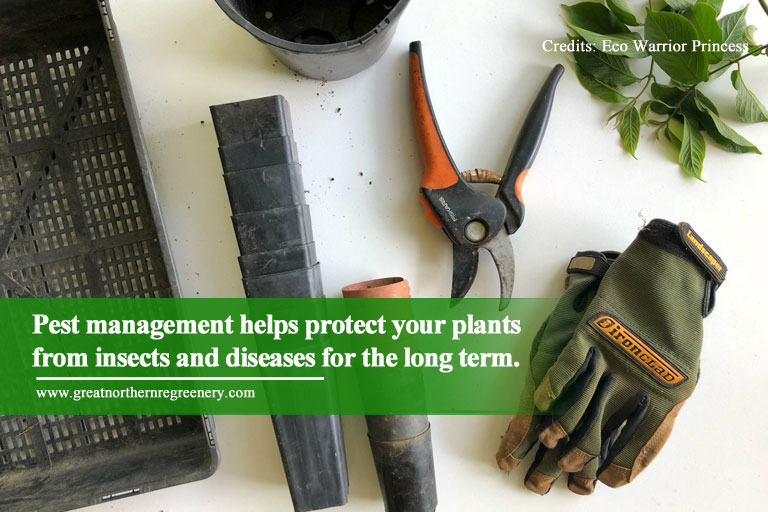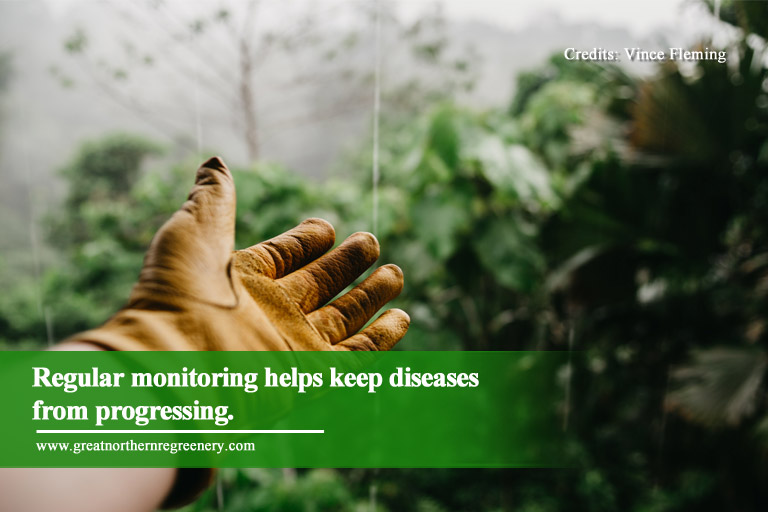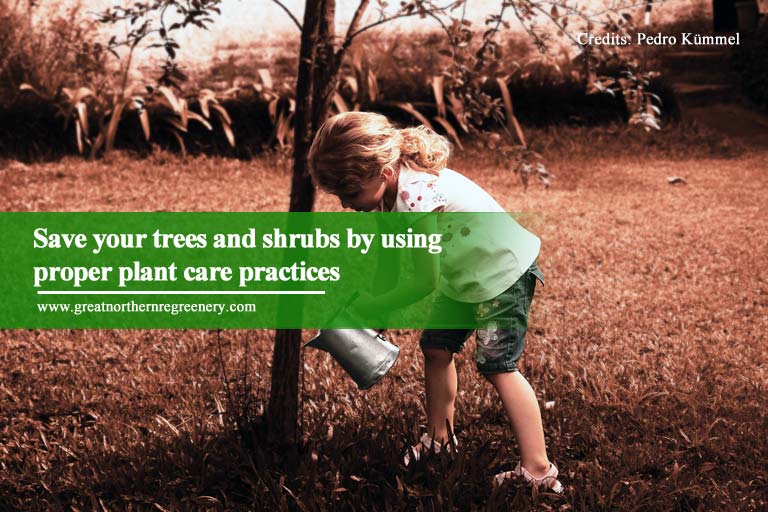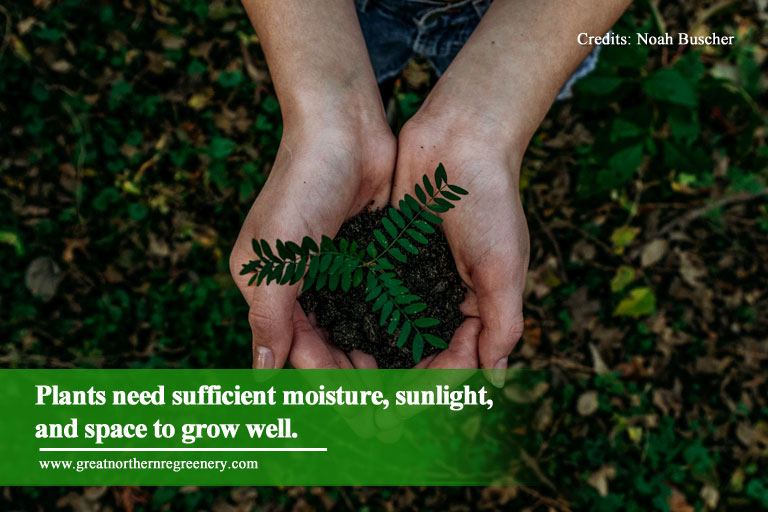Keeping your trees and shrubs healthy requires strict prevention measures. Addressing insect and disease problems at the onset is key to ensuring a healthy landscape across all seasons. By preventing disease and pest infestation before they happen rather than figuring out the solution later on, you can save hundreds of dollars on pesticides and reap the benefits of an impressive landscape.
Prevention is a three-step process which includes plant care, proper monitoring, and treatment. In many cases, prevention is followed by a method called Integrated Pest Management (IPM). This ecological approach to handling pest problems and diseases offers effective results without the use of harmful chemicals. The steps involved are guaranteed safe for people, pets, and the surroundings.
Trees and shrub diseases to look out for
Below are some of the most common diseases that plague trees and shrubs:
- Leaf spot disease – They create spots on the leaves of trees and shrubs. Leaf spots can be brownish, tan, or black and create dark spotting on leaves.
- Apple scab – This leads apple and crabapple trees to prematurely shed their leaves during late spring and early summer. A tree affected by apple scab will have leaves with brown and black spots.
- Black knot – This disease creates a soft, olive-green matter around the twigs which eventually changes to hard black knots when fall comes. Black knot often infects the fruit and branches. If left untreated, this disease can kill off a tree.
- Anthracnose – Sometimes misdiagnosed as oak wilt, anthracnose causes the leaves to develop dry, brown, and blotchy spots before they drop. Anthacrose can attack trees and shrubs early in the season.
- Cytospora canker – This disease causes discolouration on certain areas of a tree’s trunk and branches. Common among trees aged 15 years and older, cytospora canker can turn a tree’s needles to brown and kill its lower branches.
Integrated Pest Management: How does it work?

IPM involves the use of certain methods in fighting pests and diseases. These methods consistently monitor pest populations for immediate action, proper plant care practices, planting pest-resistant plant varieties, and correct treatment approaches (as needed). The goal of IPM is to develop early and long-term prevention of pests and diseases. If pest populations are reduced or eliminated at the beginning, they won’t cause massive damage in your garden/yard.
Read on to learn the essential steps involved in IPM that you can practice on your own property.
Regular monitoring

Monitoring your plants on a daily basis allows you to detect early signs of pest infestation when populations are still low and easy to eliminate. At this stage, you can interrupt their growth before they get out of control. For instance, detecting the presence of mountain pine beetle. The ideal time to monitor these pests is in the winter months.
You would know they’re taking shelter in a tree when you notice “pitch tubes” on the trunks. If you see these pitch tubes, cut off a piece of bark and check for discolouration of the wood under the bark (bluish-gray). If so, you need to call an arborist to have the tree removed. Regular monitoring of pine trees in winter and immediately removing infested trees prevents the beetles from damaging neighbouring trees. That’s why timed monitoring and instant action makes a huge difference in keeping your trees and shrubs healthy.
Proper plant care practices

Did you know that you can stop the growth of a number of pests and diseases by simply adhering to good tree and shrub care practices?
It is as simple as maintaining cleanliness and keeping your plants and beds well-tended to. This can keep insects and pests at bay. Rotating your annual crops to different parts of the garden every year helps minimize certain pest problems. Cleaning up old leaf litter on the base of plants is an effective way to ward off problematic insects. Observing the right time to plant trees and shrubs to avoid the emergence of specific types of pests also lowers the risk of plant damage.
It also pays to keep your plants well hydrated throughout the year, especially in the warmer months, as dehydrated and stressed out plants are more prone to damage. If needed, change the soil prior to planting and apply organic matter on a regular basis. Put a dense layer of organic mulch to prevent the growth of weeds and retain moisture. Take extra care of newly-planted plants, as well as trees and shrubs that have sustained damage.
Observe proper planting techniques

Here are some planting basics to remember:
- Plant varieties that can tolerate pests. In many cases, there is a resistant variety bred for a popular plant that is susceptible to specific pests. You might also want to choose varieties that are more robust, vigorous, and resistant to many pests.
- Plant the right variety in the right space. Every plant has a soil, sunlight, moisture, temperature, and space requirement to achieve optimum growth. Mismatching a plant to a wrong location or conditions will only stress it and make the plant become an easy prey for pests and diseases.
- Consider plant diversity. Once pests like the Mountain Pine Beetle infest your plants, they can potentially destroy an entire group of trees and shrubs. This is why it’s essential to grow many kinds of plants, trees, and shrubs to ensure you will have something left if the pests damage your plants. Having diverse plants in your garden or yard also helps improve the general look of your landscape.
Treat as needed

Before you resort to applying chemical treatments like insecticides, find out if there are “biological controls” available. The most common example of biological controls used in homes are beneficial insects. They are garden-friendly insects like ladybugs, praying mantis, parasitic wasps, and lacewings, that can eat up huge numbers of pests in a given time. You may want to ditch the pesticides to let the beneficials take care of the pests.
If using biological controls can’t do the trick and more aggressive pest control measures are needed, don’t hesitate to call a tree insect or tree disease expert. They are armed with the right tools and expertise to diagnose a problem and suggest the most effective and eco-friendly solutions.
However, it’s still deemed best to conduct close monitoring before any problems arise.
Have your trees and shrubs diagnosed
If you have difficulties telling whether your trees and shrubs are diseased or not, it’s a great idea to call a tree service in the Ontario area. Certified arborists are experts in diagnosing trees and offer you solutions to save your plants early on.
The arborists at Great Northern Regreenery can help you take better care of your trees. Whether you’re faced with a tree insect infestation or another form of tree disease, we’ve got everything you need to help your trees remain healthy and vibrant for years to come. Contact us today to schedule an appointment.





